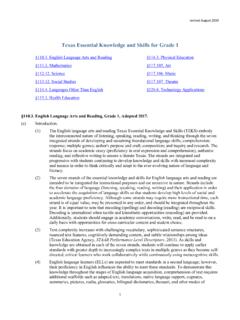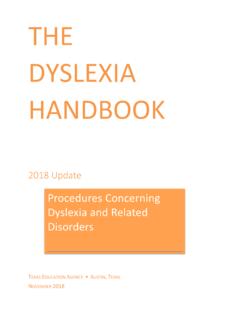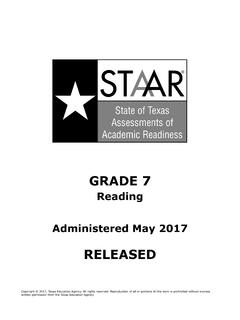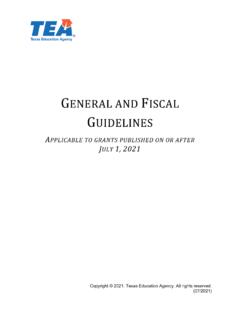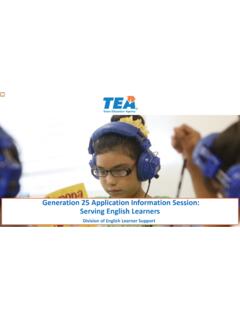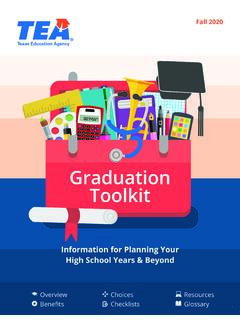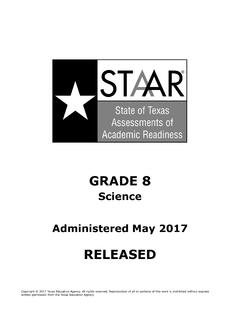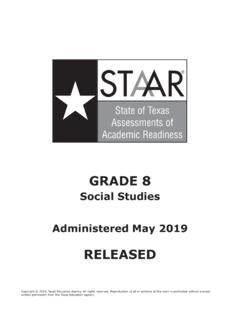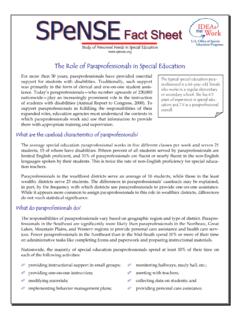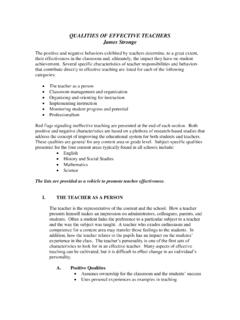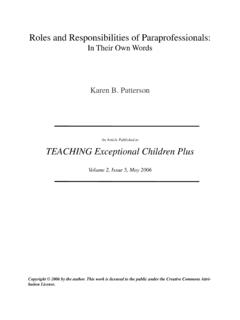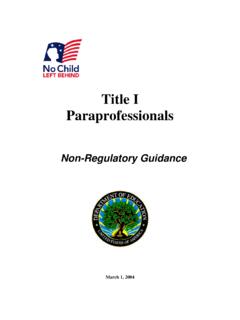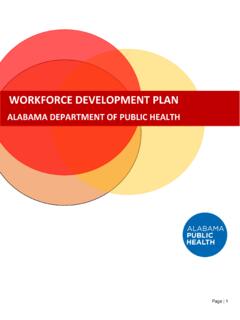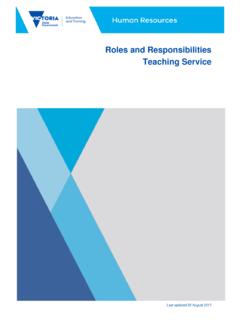Transcription of PEDAGOGY AND PROFESSIONAL RESPONSIBILITIES …
1 PEDAGOGY AND PROFESSIONAL RESPONSIBILITIES STANDARDS (EC-GRADE 12) Standard I.* The teacher designs instruction appropriate for all students that reflects an understanding of relevant content and is based on continuous and appropriate assessment. Standard II.* The teacher creates a classroom environment of respect and rapport that fosters a positive climate for learning, equity, and excellence. Standard III.* The teacher promotes student learning by providing responsive instruction that makes use of effective communication techniques, instructional strategies that actively engage students in the learning process, and timely, high-quality feedback. Standard IV. The teacher fulfills PROFESSIONAL roles and RESPONSIBILITIES and adheres to legal and ethical requirements of the profession. * The developmental characteristics of students from early childhood to grade 12, including developmentally appropriate examples and instructional strategies, are defined in the corresponding assessment framework for PPR (EC-12), as well as in the standards for PPR at each of the other three certification levels (EC-Grade 4, Grades 4-8, and Grades 8-12).
2 Standard I. The teacher designs instruction appropriate for all students that reflects an understanding of relevant content and is based on continuous and appropriate assessment. Teacher Knowledge: What Teachers Know Application: What Teachers Can Do Teachers of Students in Grades EC 12 Teachers of Students in Grades EC 12 Students Students The beginning teacher knows and understands: The beginning teacher is able to: the intellectual, social, physical, and emotional developmental characteristics plan lessons that reflect an understanding of students developmental of students in different age groups; characteristics and needs; the implications of students developmental characteristics for planning adapt lessons to address students varied backgrounds, skills, interests, and appropriate instruction; learning needs, including the needs of English language learners; characteristics and instructional needs of students with varied backgrounds, use effective approaches to address varied student learning needs and skills, interests, and learning needs; preferences.
3 Different approaches to learning that students may exhibit and what motivates plan instruction that motivates students to want to learn and achieve; and students to become active, engaged learners; acknowledge and respect cultural and socioeconomic differences among cultural and socioeconomic differences and the significance of these students when planning instruction. differences for instructional planning; and appropriate strategies for instructing English language learners. 2 Standard I. The teacher designs instruction appropriate for all students that reflects an understanding of relevant content and is based on continuous and appropriate assessment. Teacher Knowledge: What Teachers Know Application: What Teachers Can Do Teachers of Students in Grades EC 12 (continued) Teachers of Students in Grades EC 12 (continued) Content and PEDAGOGY Content and PEDAGOGY The beginning teacher knows and understands: The beginning teacher is able to: the importance of the state content and performance standards as outlined in use the Texas Essential Knowledge and Skills (TEKS) to plan instruction; the Texas Essential Knowledge and Skills (TEKS); exhibit appropriate knowledge of a subject to promote student learning; relevant content of the discipline being taught, including concepts, principles, relationships, methods of inquiry, and key issues; demonstrate awareness of common student misconceptions or likely sources of student error in relation to particular content; the significance of the vertical alignment of content, including prerequisite knowledge and skills.
4 Plan instruction that reflects an understanding of important prerequisite relationships; how lesson content and skills connect with other disciplines and within the discipline; and plan instruction that makes connections within the discipline and across disciplines; and current research on best pedagogical practices. use a variety of pedagogical techniques to convey information and teach skills. Selection of Instructional Goals and Objectives Selection of Instructional Goals and Objectives The beginning teacher knows and understands: The beginning teacher is able to: the importance of developing instructional goals and objectives that are clear, develop instructional goals and objectives that are clear, relevant, meaningful, relevant, meaningful, and age-appropriate; and age-appropriate; the importance of developing instructional goals and objectives that can be develop instructional goals and objectives that are able to be assessed; assessed; develop instructional goals and objectives that reflect students age, the importance of developing instructional goals and objectives that are mental level, prior skills and knowledge, background, and interests; and suitable for students with varied learning needs.
5 And develop instructional goals and objectives that reflect different types of the importance of aligning instructional goals with campus and district goals. student learning and skills. 3 Standard I. The teacher designs instruction appropriate for all students that reflects an understanding of relevant content and is based on continuous and appropriate assessment. Teacher Knowledge: What Teachers Know Application: What Teachers Can Do Teachers of Students in Grades EC 12 (continued) Teachers of Students in Grades EC 12 (continued) Resources Resources The beginning teacher knows and understands: The beginning teacher is able to: the use of appropriate materials and resources for preparing instruction, use various types of materials and other resources to aid in preparing and presenting lessons, and assessing learning; implementing instruction; the importance of knowing when to integrate technology into instruction and use technological tools to promote learning and expand instructional options; assessment; and and the use of resources beyond the campus to help students meet academic and use resources available outside the school ( , museums, businesses, nonacademic needs.)
6 Community members) to enhance students learning opportunities. Designing Coherent Instruction Designing Coherent Instruction The beginning teacher knows and understands: The beginning teacher is able to: the importance of designing instruction that reflects the TEKS; plan instructional activities that progress sequentially and support stated instructional goals based on the TEKS; features of instruction that maximize students thinking skills; select instructional resources that support instructional goals, enhance student the importance of planning lessons and structuring units so that activities achievement, and engage students in learning; progress in a logical sequence; use varied activities and instructional groupings to engage students in how materials, technology, and other resources may be used to support instructional content and meet instructional goals and objectives; instructional goals and objectives and engage students in meaningful learning.
7 Allocate time appropriately within lessons and units, including providing the benefits of designing instruction that integrates content across disciplines; adequate opportunities for students to engage in reflection and closure; and and provide students with opportunities to explore content from many the importance of engaging in continuous monitoring and self-assessment of perspectives. instructional effectiveness. 4 Standard I. The teacher designs instruction appropriate for all students that reflects an understanding of relevant content and is based on continuous and appropriate assessment. Teacher Knowledge: What Teachers Know Application: What Teachers Can Do Teachers of Students in Grades EC 12 (continued) Teachers of Students in Grades EC 12 (continued) Assessment of Student Learning Assessment of Student Learning The beginning teacher knows and understands: The beginning teacher is able to: the role of assessment in guiding instructional planning; use a variety of assessment methods, including technology, that are appropriate for evaluating student achievement of instructional goals and the importance of creating assessments that are congruent with instructional objectives; goals and objectives; communicate assessment criteria and standards to students; the characteristics, uses, advantages, and limitations of various assessment methods and strategies; design assessments, where appropriate, that reflect real-world applications of knowledge and understanding; the role of technology in assessing student learning.
8 Promote students use of self-monitoring and self-assessment; the benefits of and strategies for promoting student self-assessment; analyze assessment results to aid in determining students strengths and the connection between the Texas statewide assessment program, the TEKS, needs; and and instruction; and use assessment results to help plan instruction for groups of students or how to analyze data from local, state, and other assessments using common individuals. statistical measures. 5 Standard II. The teacher creates a classroom environment of respect and rapport that fosters a positive climate for learning, equity, and excellence. Teacher Knowledge: What Teachers Know Application: What Teachers Can Do Teachers of Students in Grades EC 12 Teachers of Students in Grades EC 12 Creating an Environment of Respect and Rapport Creating an Environment of Respect and Rapport The beginning teacher knows and understands: The beginning teacher is able to: the importance of creating a learning environment in which diversity and individual differences are respected; interact with students in ways that reflect support and show respect for all students; the impact of teacher-student interactions and interactions among students on classroom climate and student learning and development; and use strategies to ensure that interactions among students are polite, respectful, and cooperative; and ways to establish a positive classroom climate that fosters active engagement in learning among students.
9 Use strategies to ensure that the classroom environment and interactions among individuals and groups within the classroom promote active engagement in learning. Establishing an Environment for Learning and Excellence Establishing an Environment for Learning and Excellence The beginning teacher knows and understands: The beginning teacher is able to: the importance of communicating enthusiasm for learning; and the necessity of communicating teacher expectations for student learning. communicate to all students the importance of instructional content and the expectation of high-quality work; and ensure that instructional goals and objectives, activities, classroom interactions, assessments, and other elements of the classroom environment convey high expectations for student achievement. 6 Standard II. The teacher creates a classroom environment of respect and rapport that fosters a positive climate for learning, equity, and excellence.
10 Teacher Knowledge: What Teachers Know Application: What Teachers Can Do Teachers of Students in Grades EC 12 (continued) Teachers of Students in Grades EC 12 (continued) Managing Classroom Procedures Managing Classroom Procedures The beginning teacher knows and understands: The beginning teacher is able to: how classroom routines and procedures affect student learning and establish classroom rules and procedures to promote an organized and achievement; productive learning environment; how to organize student groups to facilitate cooperation and productivity; organize and manage groups to ensure that students work together cooperatively and productively; the importance of time management for effective classroom functioning; schedule activities and manage class time in ways that maximize student procedures for managing transitions; learning; routines and procedures for managing and using materials, supplies, and manage transitions to maximize instructional time; technology; implement routines and procedures for the effective management of noninstructional duties ( , taking attendance) and procedures for materials, supplies, and technology; performing these duties effectively; and coordinate the performance of noninstructional duties with instructional the classroom roles of paraprofessionals , volunteers, and other professionals, activities; including substitute teachers, in accordance with district policies and procedures.
